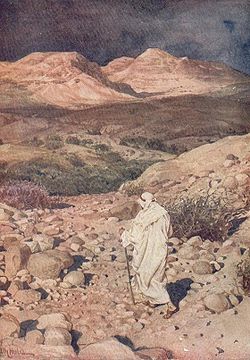- Matthew 4:1
-
Matthew 4:1 is the first verse of the fourth chapter of the Gospel of Matthew in the New Testament. This verse opens the section in Matthew dealing with the temptation of Christ by Satan. Jesus has just been baptized by John the Baptist in this verse he is led out into the wilderness.
In the King James Version of the Bible the text reads:
- Then was Jesus led up of the
- Spirit into the wilderness
- to be tempted of the devil.
The New International Version translates the passage as:
- Then Jesus was led by the
- Spirit into the desert to
- be tempted by the devil.
For a collection of other versions see BibRef Matthew 4:1
The verse makes clear that the Spirit, presumably the Holy Ghost prominently mentioned two verses before in Matthew 3:16, is the one who leads Jesus into the desert. France states that it is clear that while Satan's goals were his own, the testing of Jesus was ordained by God. France also feels that tempted is a poor translation and that. He argues that the devil was testing Jesus.[1] Led up refers specifically to moving upwards geographically, likely linking to climbing from the river side of the Jordan to a location of higher latitude in the wilderness.[2] Keener notes that the specific wording may also be a reference to God leading his people into the wilderness in Exodus.[3]
There is no evidence of what specific wilderness area is being referred to, other than that it was at a higher level than the river. Jones reports that the wilderness mentioned here has since the fifth century been believed to be the rocky and uninhabited area between Jerusalem and Jericho. A spot on Mount Quarantania is traditionally the exact location, and a Greek Orthodox monastery exists on the spot today. Jones notes that this was Jesus meeting the devil on the devil's ground. The desert is seen as outside the bounds of society and as the home of demons.[4] Other scholars, such as France, disagree arguing that the wilderness was considered pure and holy in contrast to the corrupting cities. France also notes that Matthew 12 has the waterless dessert as a place unpleasant to demons.[5] Heading into the desert to battle with demons became an important part of the monastic tradition in later centuries.
Gundry notes that some have read this reference to the wilderness as a comparison to Adam in the Garden of Eden. Implying that this time Jesus will not sin, and thus redeem humanity. Gundry rejects this idea and believes that nowhere does Matthew's text imply such a comparison. Rather Gundry supports the popular view that the reference to the wilderness is an allusion to the Israelites after the Exodus and specifically to Moses.[6]
Matthew here uses the Greek word diabolos rather than the Hebrew satan used in Mark. Both words roughly translate as accuser, but it seems clear that both terms were understood as the name of a specific being at the time Matthew was writing. Matthew gives no details about the devil. The devil's status as a fallen angel, his tail and pitchfork, and other embellishments are found nowhere in the Bible and were all products of later writings. In earlier parts of the Old Testament such as the Book of Job and 1 Chronicles the devil is portrayed as a lieutenant of God who works in a role that Albright and Mann describe as the "opposing council," testing humans on behalf of God. Over time, perhaps under the influence of Iranian dualism, Satan became the great antagonist and this was the view that was current by the time the gospels were written. However, this verse seems to somewhat echo Satan's early role as God's tester.[7]
References
- ^ France, R.T. The Gospel According to Matthew: an Introduction and Commentary. Leicester: Inter-Varsity, 1985.
- ^ France, R.T.. The Gospel of Matthew. Wm. B. Eerdmans Publishing, 2007 pg. 129
- ^ Keener, Craig S. A commentary on the Gospel of Matthew. Wm. B. Eerdmans Publishing, 1999. pg. 137
- ^ Jones, Alexander. The Gospel According to St. Matthew. London: Geoffrey Chapman, 1965.
- ^ France, R.T.. The Gospel of Matthew. Wm. B. Eerdmans Publishing, 2007 pg. 129
- ^ Gundry, Robert H. Matthew a Commentary on his Literary and Theological Art. Grand Rapids: William B. Eerdmans Publishing Company, 1982.
- ^ Albright, W.F. and C.S. Mann. "Matthew." The Anchor Bible Series. New York: Doubleday & Company, 1971.
Gospel of Matthew Preceded by:
Matthew 3:17Chapter 4 Followed by:
Matthew 4:2Categories:- Gospel of Matthew verses
Wikimedia Foundation. 2010.

